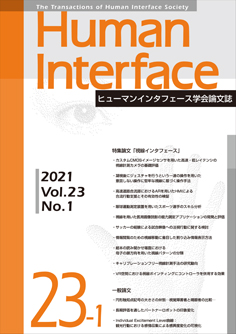Volume 23, Issue 1
Displaying 1-13 of 13 articles from this issue
- |<
- <
- 1
- >
- >|
Papers on Special Issue Subject “Gaze Interface”
-
Article type: Short Note
2021Volume 23Issue 1 Pages 1-4
Published: February 25, 2021
Released on J-STAGE: February 25, 2021
Download PDF (6595K) -
Article type: Original Paper
2021Volume 23Issue 1 Pages 5-18
Published: February 25, 2021
Released on J-STAGE: February 25, 2021
Download PDF (3840K) -
Article type: Original Paper
2021Volume 23Issue 1 Pages 19-28
Published: February 25, 2021
Released on J-STAGE: February 25, 2021
Download PDF (2842K) -
Article type: Original Paper
2021Volume 23Issue 1 Pages 29-42
Published: February 25, 2021
Released on J-STAGE: February 25, 2021
Download PDF (6088K) -
Article type: Short Note
2021Volume 23Issue 1 Pages 43-46
Published: February 25, 2021
Released on J-STAGE: February 25, 2021
Download PDF (1158K) -
Article type: Short Note
2021Volume 23Issue 1 Pages 47-50
Published: February 25, 2021
Released on J-STAGE: February 25, 2021
Download PDF (489K) -
Article type: Original Paper
2021Volume 23Issue 1 Pages 51-64
Published: February 25, 2021
Released on J-STAGE: February 25, 2021
Download PDF (4724K) -
Article type: Original Paper
2021Volume 23Issue 1 Pages 65-72
Published: February 25, 2021
Released on J-STAGE: February 25, 2021
Download PDF (2386K) -
Article type: Review Paper
2021Volume 23Issue 1 Pages 73-88
Published: February 25, 2021
Released on J-STAGE: February 25, 2021
Download PDF (8497K) -
Article type: Original Paper
2021Volume 23Issue 1 Pages 89-100
Published: February 25, 2021
Released on J-STAGE: February 25, 2021
Download PDF (2316K)
Papers on General Subjects
-
Article type: Original Paper
2021Volume 23Issue 1 Pages 101-108
Published: February 25, 2021
Released on J-STAGE: February 25, 2021
Download PDF (6621K) -
Article type: Original Paper
2021Volume 23Issue 1 Pages 109-120
Published: February 25, 2021
Released on J-STAGE: February 25, 2021
Download PDF (2509K) -
Article type: Original Paper
2021Volume 23Issue 1 Pages 121-134
Published: February 25, 2021
Released on J-STAGE: February 25, 2021
Download PDF (3369K)
- |<
- <
- 1
- >
- >|
